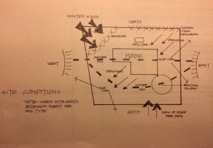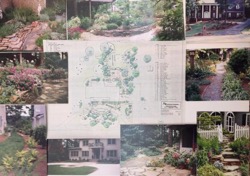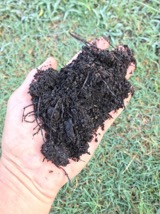Basic Steps for Home Landscaping
go.ncsu.edu/readext?548384
en Español / em Português
El inglés es el idioma de control de esta página. En la medida en que haya algún conflicto entre la traducción al inglés y la traducción, el inglés prevalece.
Al hacer clic en el enlace de traducción se activa un servicio de traducción gratuito para convertir la página al español. Al igual que con cualquier traducción por Internet, la conversión no es sensible al contexto y puede que no traduzca el texto en su significado original. NC State Extension no garantiza la exactitud del texto traducido. Por favor, tenga en cuenta que algunas aplicaciones y/o servicios pueden no funcionar como se espera cuando se traducen.
Português
Inglês é o idioma de controle desta página. Na medida que haja algum conflito entre o texto original em Inglês e a tradução, o Inglês prevalece.
Ao clicar no link de tradução, um serviço gratuito de tradução será ativado para converter a página para o Português. Como em qualquer tradução pela internet, a conversão não é sensivel ao contexto e pode não ocorrer a tradução para o significado orginal. O serviço de Extensão da Carolina do Norte (NC State Extension) não garante a exatidão do texto traduzido. Por favor, observe que algumas funções ou serviços podem não funcionar como esperado após a tradução.
English
English is the controlling language of this page. To the extent there is any conflict between the English text and the translation, English controls.
Clicking on the translation link activates a free translation service to convert the page to Spanish. As with any Internet translation, the conversion is not context-sensitive and may not translate the text to its original meaning. NC State Extension does not guarantee the accuracy of the translated text. Please note that some applications and/or services may not function as expected when translated.
Collapse ▲Landscape Planning and Site Analysis
Marshall Warren-Extension Agent-Horticulture
First, make an inventory map of your property and identify existing property line boundaries, home orientation, physical features, i.e. soils, trees, shrubs, views, wind direction, site potentials. From this information, develop a site analysis and determine how you can address problems and take advantage of existing opportunities. Interpret your conditions such as sun, shade, wet and dry areas, drainage, slope, and potential erodible areas, traffic circulation, and views.
Things to take note of:
- Northside of buildings are always shady
- Afternoon shade is on the east side of a structure
- The Southwest side of the structure is always going to receive the hottest sun unless shaded by a tree
- Microclimate areas
- Water moves downhill – will water drain away from the home and are there places where water settles
- Soil conditions – good or bad drainage and its ability to grow plants (pH & nutrients)
- Underground and overhead utility and power lines, septic tank and/or sewer easements, right of ways, and restrictive covenants.
- Paths for vehicular and pedestrian traffic
Begin to create a design that will correct and enhance areas to best utilize your property and create curb appeal. Assess your family’s needs and determine areas to utilize space for these needs. Consider access to and around the house. Determine family activities such as outdoor entertaining, pet and children’s play areas, ornamental and vegetable gardening, etc. Plan for utility storage areas and future yard maintenance issues.
Consider plants and hardscape features as you would furniture in your home. Arrange them on your plan to create spaces, focal points, and views, garden rooms, direct traffic flow patterns, make changes in elevation, and create transition spaces. Consider formal or informal design. Think about color and patterns. Your goal is a garden that will be both aesthetically pleasing and functional. Don’t worry yet about what specific plant goes where, just consider them for their size and form. I will cover this and help educate you on plant choice in the next “Gardener’s Dirt” issue. Stay tuned.
Landscape Design: Choosing Plants
|
In the January 2017 issue of The Gardener’s Dirt, I wrote about the importance of landscape planning and site analysis. Continuing with this series, I will discuss how to choose plants for your design. In review, you should make an inventory map of your property, identifying the conditions of your site, such as sun, shade, wet and dry areas, and documenting any problem areas, as well as potential areas for planting. Familiarity with your site’s conditions will be advantageous in choosing the best plants that will thrive while creating your desired effect.
|
The next step is to sketch your vision on a landscape plan of your property and home. Decide on a formal or an informal design, and begin your plant design composition with the main structure plants, the large, mostly evergreen background plants, and trees. Consider plants, lawns, and hardscape features as you would furniture in your home. Arrange them to create spaces, focal points, and views, garden rooms, direct traffic flow patterns, make changes in elevation, and create transition spaces. The second layer of mid-ground plants is for massing and infill. The final layer of plants, the foreground plants, including low growing plants, perennials, and groundcovers that provide emphasis and focal points.
Position trees and shrubs strategically to naturally cool or heat your home. Plant deciduous shade trees on the south, east, and west sides of a house to cast shade in summer and allow warming in winter. When planning a grass area, carefully consider which type of turfgrass is best for your site conditions and your desired maintenance level.
It’s good to try to create year-round interest when choosing plants. In addition, don’t forget to take into account what times of year different plants bloom, also consider other interesting features plants offer such as colorful and peeling bark, spring, summer, and fall color, foliage texture, fragrance, pollinator-friendly plants as well as fruit-producing plants. Consider the different growth habits and forms of plants, such as upright, cascading, rounded, weeping, spreading, mounding, and vase-shaped growth. Your goal is a garden that will be both aesthetically pleasing and functional.
Choosing plants can be an exciting endeavor, but resist the design mistake of over-planting. You want to avoid a crowded landscape and the need for future removal of plants you have grown to love. Also, avoid lawn areas scattered with trees and shrubs making the landscape look disorganized and maintenance nightmares such as planting large trees under utility lines, shrubs planted too close to the foundation, and plant choices that grow too tall covering windows resulting in excessive pruning.
You may have heard the phrase “Right Plant, Right Place”. Think about the future and take into account how the passage of time will affect the overall design. Consider the plant’s growth rate, maintenance needs, and its eventual size at maturity.
The plants you select should be cold hardy in the appropriate climate zone. In Johnston County, we are in zone 7. A plant that is adapted to your hardiness zone is one that can tolerate the lowest winter temperature your zone usually experiences. To create and maintain a healthy landscape, choose plants that are suited to the conditions in your yard. Plants placed in a location that meets their requirements usually thrive without requiring a lot of attention. Learn the specific needs and growth habits of each plant before you buy them.
While you are out and about, pay close attention to plants in the landscape that are thriving and attractive that you would like to include in your landscape plan. Pay particular attention to its growing environment. If you don’t know the name of the plant, take a photo and ask your local nurserymen, garden center, or County Cooperative Extension office to identify it. Aim for diversity in your plant selections. Some people only consider native plants, but just because a plant is native, it still may have problems, especially if it is placed in a location that does not meet its requirements. Sometimes, exotic plants are more resistant to pests than are their native relatives.
When searching for plants at your local garden center, ask for plants that are grown by Johnston County Nurserymen, or better yet visit your local Johnston County Nursery that offers retail to the public.
If you haven’t already taken a soil test and delivered it to the County Cooperative Extension office or to the N.C. Department of Agriculture & Consumer Services’ soil testing labs, go ahead and do so before you do any planting. Soil testing and soil preparation is the beginning step of having a good foundation for your new plants or maintaining your existing plantings. In the May issue of the Gardener’s Dirt, I will discuss soil preparation. Stay tuned.
For eye-catching plants grown by Johnston County Nursery Marketing Association, ask for the “Choice Plant” Series.
Landscape Installation: Grading, Drainage, and Soil Preparation
|
In the January 2017 issue of “The Gardener’s Dirt”, I wrote about the importance of landscape planning and site analysis, and in the May issue, I focused on refining your vision by creating a landscape design and choosing plants. In this issue, you will learn about the steps needed to implement your design. 1. Have a soil test in hand so you can correct any soil nutrient and pH deficiencies. If you haven’t taken a soil test yet, stop reading now and go do it. |
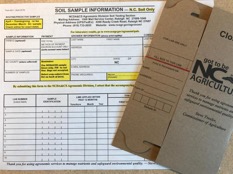
Photo Courtesy of Marshall Warren |
- Establish priorities and a budget. A landscape installation can be very simple or extremely complicated. By establishing priorities, you can implement the landscape in stages. Decide which part of the landscape is most important, and consider the time of the year that is best to install certain parts, and consider your needs and budgetary constraints. You should also evaluate the skills and materials needed for installation and associated costs to determine whether these are DIY projects or whether money and time would be better spent by hiring a professional. When the job seems too big, call in a licensed professional landscape contractor.
- Locate underground cables and utilities. Before you plan to grade or dig in an area, it is important to know the location of all above and below ground utilities such as cable, phone, gas, water, electricity lines, and septic tank fields. To have the utility lines located for free, call 811 or 1-800-632-4949. Allow three working days before you plan on digging. Example: call Monday and dig on Friday.
- Remove or kill any unwanted and noxious weeds. Before you prepare or grade the soil. Example: If you have Bermuda grass in unwanted areas and you would like to seed a Centipede grass lawn next spring; you will need to kill Bermuda before it goes dormant.
- Grading and Drainage. Observe your yard during a heavy rainstorm to determine how your yard handles runoff; note areas of maximum flow, puddling, or erosion. Your landscape plan should have been designed to eliminate or reduce the amount of water runoff entering storm sewers or onto your neighbor’s property. Keeping water on site will help recharge groundwater. Install any needed swales, terraces, retaining walls, catch basins and piping to redirect, or allow water penetration, thus preventing erosion. If extensive grading is needed, remove the topsoil and stockpile it for replacement after the rough grade is established. The rough grade should conform to the final grade after the topsoil is replaced.
Compaction is likely a problem if there has been recent construction or other traffic over the area. To help determine if your soil’s subsurface drainage is adequate, it can be checked by digging several 18″ holes around your property and filling them with water. If the water doesn’t drain away within a couple of hours, subsurface drainage is inadequate and should be improved by deeply breaking up the soil to reduce compaction and allow air and water penetration. To simplify – if a pickax appears to be the best tool for digging a planting hole, then your soil is probably too compacted; if the soil is fairly easy to dig into with a shovel, then it is probably not compacted.
Don’t forget, if any hardscaping is to be done, make allocations for future easy accessibility of drainage lines, electrical, and irrigation by installing underground access pipes.
- Soil Preparation. Given the time, effort, and money required for most landscape projects, it’s important to get off to the best start possible – beginning with proper soil preparation. This certainly isn’t the most exciting or glamorous aspect of a landscape project – however, it may be the most crucial for ensuring long-term success and the results are typically worth the investment.
More often than not – gardeners usually think about the chemical aspects first. Things like fertilizers, root stimulators, soil additives, etc. Sure, these are important – but it’s the physical properties of soil that can make or break a landscape planting. For optimum health and growth, plant roots need a good balance of air and water. Why is this important? Landscape soils that hold too much water typically have problems with root diseases. A significant lack of oxygen in the soil can also result in damage to the root system and ultimately plant death.
|
If you have hard, compacted soil, its condition can be improved by deep cultivation, amending the soil with organic matter, and applying the required nutrients, and adjusting the pH as recommended by your soil test report. Deep cultivation is the mixing of the top 6 inches to 2 feet of soil (depending on the severity of compaction) with either a backhoe, tiller, disk, or hand tools. Incorporation of organic matter during deep cultivation can help to rehabilitate soil structure by creating aggregates and both macropores (for drainage) and mesopores (for plant-available water). The best organic matter for use in landscape soils has a good distribution of coarse and fine particles. The finer the organic matter, the greater the water-holding characteristics. The best amendments for clay soils are pine bark fines ½ inch diameter, and/ or compost, such as composted leaves. The addition of compost will also improve the conditions and water retention in sandy soils. Till soil when it is moist, but don’t work the soil when it is too wet, because it can cause it to become tight and compacted. |
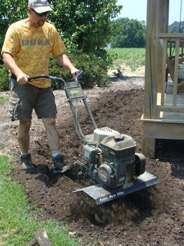
Photo Courtesy of Dana Warren |
|
Pine Bark Fines |
Composted Leaves |
If you don’t have an adequate depth of quality soil in all planting areas the importation and spreading of quality topsoil and/or incorporation of composts to support landscape planting may be required. Adding this new topsoil to existing soil may also create drainage problems when water moves through the purchased topsoil and reaches the compacted layer. The water can pool and create unfavorable conditions for root growth. It is important to not just spread topsoil over these compacted areas without first deeply breaking and loosening them to allow for air and water penetration. Afterward, it is okay to add the topsoil and amendments. |
If you are planting trees, it is best to not amend the soil with organic matter in each hole, but to use the existing soil to backfill the hole, or better yet, you may plant it within a large amended planting bed.
Now is a good time to get out and start preparing your soil. Once it is ready, go ahead and apply a 2 to 3″ layer of mulch to control weeds, and then wait until fall which is the most favorable planting season. Once fall arrives and the fun of installing your plants from your landscape design begins, you will have confidence that you are giving them the best start possible.





